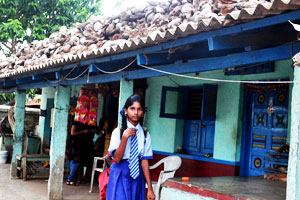With just three months left for Karnataka to file a compliance report on a law guaranteeing free, compulsory education to children aged six to 14, many schools seem to be flouting the norms fearlessly.
Located in Shivajinagar, Kannada- medium Hafzia Higher Elementary school has poor hygiene standards and lacks basic facilities. Apart from this, the school doesn’t have a proper toilet for girls. Provision of such facilities is stipulated in the Right to Education.
Reena, a sixth-grade student, told us, “There is no proper toilet for girls in our school, and we face lots of problems during school hours.”
The situation is no different at the Government Urdu Higher Primary School in Malleshwaram, which has a playground, but not a single toilet for girl students in the school.
“We had separate toilet for girls but it collapsed a few days ago. The process of reconstructing the toilet is under progress,” the principal of the school said.
According to information provided by officials of the Sarva Shiksha Abhiyan free-education program, only 56 per cent of the schools in Karnataka had separate toilets for girls as of the end of 2011 and there has been an 11 percent dropout rate in secondary education in government schools from 2009 to 2011. Not only this, there has been a constant fall in the enrollment rate in secondary education.
Blaming lack of proper toilets in schools as the major reason for an increase in number of dropout rates, a spokesperson from NGO called Child Rights and You (CRY) said that around 30 per cent of the girls in Karnataka have either not gone to school or are dropouts.
Prabha Alexander, junior education officer, Sarva Shiksha Abhiyan, said, “The funds are always given to schools, but the school authorities should make proper use of them in providing basic infrastructural facilities especially toilets for girls.”
A survey conducted amongst parents by CRY in 2011 in various cities, including Bangalore, states that “toilets remains the single most commonly voiced concern for girl students and their parents across India among the lower-income group.”
The secondary data of the survey states that 44 per cent of schools covered by the RTE act have separate toilet facilities for girls. In the rest, girls need to run to the nearby fields or run back to their homes to use the toilets.
The RTE act, which came into force on April 1, 2009, requires all the schools to abide by the given infrastructure rules within three years. The last date to meet the infrastructural norms mentioned in the act is March 31, 2013.
**The story was earlier posted in http://www.thesoftcopy.in/06_12_12_sakshi_education.html
Sakshi Saxena is a Multimedia Trainee Journalist studying in Indian Institute of Journalism and New Media, Bangalore.






